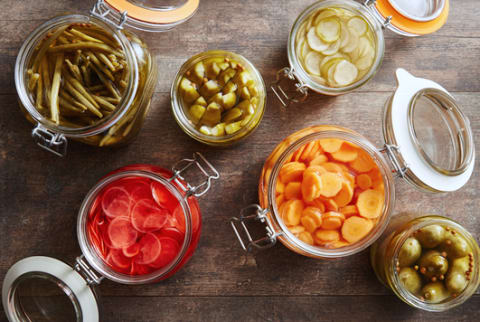Advertisement

The age-old adage "you are what you eat" couldn't be more true—the nutrients in your food supply your body with all it needs to grow and survive.
With every bite you take, these micro and macronutrients lay the foundation for every cell in your body. Macronutrients are the carbohydrates, proteins and fats in our foods that provide us with energy. You need these in larger quantities than micronutrients—the vitamins, minerals and antioxidants that comprise our food.
While our bodies don't require as many of these nutrients, they play an integral role in promoting your health and staving off illness. Picture your body as a house: macronutrients define the basic bricks, doors, and windows, while micronutrients are the mortar that adheres the bricks, the joists that support the ceiling, and the hinges that allow the doors to swing.
And what good is a door without hinges?
Whole foods like fruits and vegetables contain far more of these beneficial micronutrients than the processed foods, refined grains, starches and cereals on shelves today.
By becoming more aware of the beneficial micronutrients in certain foods, you can tailor your diet to include more of them. So, without further ado, here are five essential micronutrients and where to find them:
1. Folate
Folate is one of the eight types of B vitamins, and it helps with the formation of red blood cells. It is water-soluble, and also called vitamin B9. Folate is a general term that actually implicates a family of nutrients naturally occurring in healthy foods—nutrients such as methylfolates and dihydrofolates. It's not to be confused with folic acid—a synthetic found in vitamins, supplements, and fortified foods that's a known toxin large quantities.
The best way to get your B9 is through fruits and vegetables. Legumes like lentils and beans, spinach and asparagus are all great, folate-rich options.
Fun fact: the root word of folate is folium, the Latin word for leaf (akin to words like foliage) due to its abundance in leafy greens.
2. Iron
Iron is used to create hemoglobin, which is the substance in red blood cells that carries and delivers oxygen around the body. Iron deficiency is one of the most common nutritional deficiencies. If you are ever suffering from fatigue, mild shortness of breath or frequent paresthesia (the tingly feeling you get in your hands and feet from lack of circulation), you may be experiencing an iron deficiency.
There are two types of iron: heme, which comes from an animal source, and non-heme, which is obtained through a plant. Heme iron is more bioavailable, meaning it's easier for your body to absorb. This kind of iron is found most abundantly in clams, oysters, beef, lamb and turkey. Non-heme iron is in beans like lima and red kidney beans, chickpeas, lentils, tofu, broccoli and spinach. And, if you're looking to up your iron intake while snacking, I recommend kale chips.
3. Magnesium
Did you know that consuming sodas, sugar and caffeine actually causes your body to lose magnesium? The sugars and phosphates found in these beverages bind with magnesium, causing the kidneys to excrete it before it's been properly absorbed. This means that even if you consume a ton of magnesium, your body may not be absorbing enough of it. Frequent muscle cramps, spasms, anxiety and excess tension can be caused by a magnesium deficiency, as magnesium is a natural muscle relaxer.
If you're looking to consume more magnesium, you can find it in dark, leafy greens like spinach and Swiss chard; nuts and seeds, such as almonds, cashews, sesame and pumpkin seeds; and whole, unrefined grains like brown rice and quinoa. You can even find it in dark chocolate! (As if you need another excuse to indulge your sweet tooth.)
4. Vitamin A
Essential for maintaining vision, vitamin A describes a group of fat-soluble retinoids, like retinol. Retinol is created from carotenoids, such as beta-carotene, which is often associated with foods of an orange hue (though it can also be found in dark, leafy greens). This means that when you eat foods like carrots, spinach and sweet potatoes, you consume beta-carotene, some of which is converted into vitamin A. Sweet potato chips are an awesome snack to help satisfy your daily vitamin A requirement.
The amount of beta-carotene that is successfully converted into vitamin A varies greatly depending on the food source, so it's helpful to consume the nutrient from a variety of foods. The most bioavailable sources of vitamin A come from animals, and can be found in foods like liver, grass-fed dairy products and egg yolks.
5. Vitamin D
Due to the increased amount of time we're spending indoors, people are becoming more and more vitamin D deficient. Though often overlooked, vitamin D is extremely important. Widespread deficiency has been deemed partially responsible for rising levels of depression and autoimmune disorders, laying the foundation for many chronic illnesses
Vitamin D is created when your skin is exposed to ultraviolet rays from the sun, and is not adequately produced while wearing sunscreen. That is not to say you shouldn't slather on the SPF if you're out for the day, but you should allow yourself 10 to 20 minutes of midday sun exposure regularly. If you're not able soak up some sun, you can also find vitamin D in fatty fish and fish oils, canned tuna, egg yolks, mushrooms (especially shiitake and portobello), and tofu.
